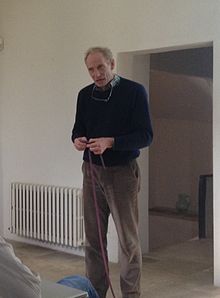Kim Nasmyth
| Kim Nasmyth | |
|---|---|

Kim Nasmyth explains loop extrusion with climbing rope
|
|
| Born | Kim Ashley Nasmyth October 10, 1952 |
| Institutions | |
| Alma mater |
|
| Thesis | DNA replication in Schizosaccharomyces pombe (1977) |
| Doctoral advisor | Murdoch Mitchison |
| Doctoral students |
|
| Notable awards |
|
|
Website library |
|
Kim Ashley Nasmyth FRS (born 18 October 1952) is an English geneticist, the Whitley Professor of Biochemistry at the University of Oxford and a Fellow of Trinity College, Oxford. He is best known for his work on the segregation of chromosomes during cell division.
Nasmyth was born in London in 1952. He attended Eton College, Berkshire, then the University of York, where he studied Biology. Nasmyth went on to complete his graduate studies in the group of Murdoch Mitchison at the University of Edinburgh. Here he worked on the cell cycle alongside Paul Nurse and his PhD thesis focuses on the control of DNA replication in fission yeast. In Mitchison's lab he made substantial contributions to the study of the cell cycle in fission yeast isolating and characterizing cell cycle mutants and the first identification of a gene product (DNA ligase) in these mutants.
Nasmyth joined Ben Hall's lab in Seattle as a postdoctoral researcher where he developed ways of cloning genes by complementation in yeast and, in collaboration with Steve Reed, cloned the CDC28 gene from the budding yeast Saccharomyces cerevisiae.
As a group leader in Cambridge Nasmyth became interested in the phenomenon of mating-type switching in yeast. Together with Kelly Tatchell he cloned the S. cerevisiae mating-type locus and found, surprisingly, that ‘silent’ copies of the mating-type genes including their promoters are maintained in the yeast chromosome. This represented the first case where the position of a gene in the chromosome had demonstrable biological significance, and prompted Nasmyth to abandon work on the cell cycle for a time and concentrate instead on studying gene silencing. He was one of the first to demonstrate that gene expression can be regulated through specific control elements which are distant from the start of transcription.
...
Wikipedia
